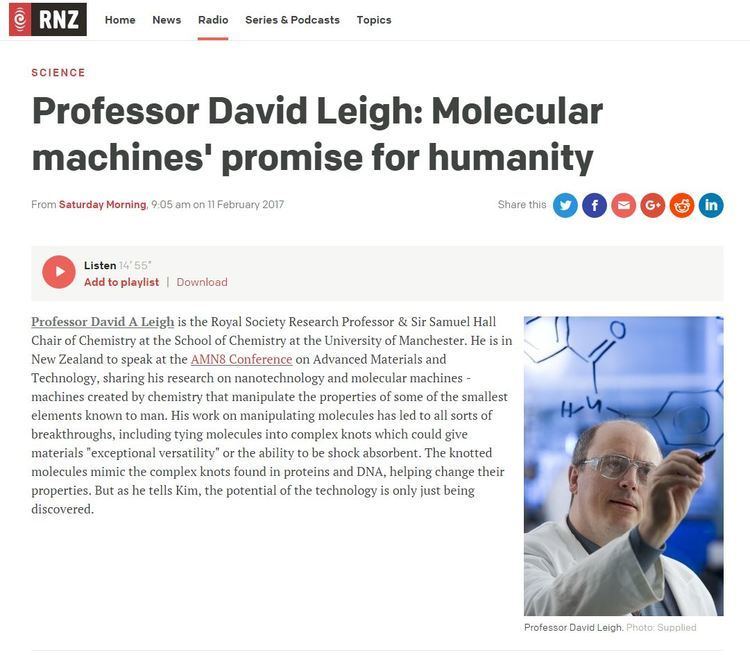Nationality British | Role University Professor Name David Leigh Doctoral advisor Fraser Stoddart | |
 | ||
Institutions University of ManchesterUniversity of EdinburghUniversity of WarwickUniversity of Sheffield Thesis The synthesis and properties of novel and natural macrocyclic trichothecenes (1987) Notable awards Fellow of the Royal SocietyFellow of the Royal Society of EdinburghFeynman Prize in Nanotechnology (2007) | ||
David Alan Leigh (born 1963) FRS FRSE FRSC is a British chemist, Royal Society Research Professor and, since 2014, the Sir Samuel Hall Chair of Chemistry in the School of Chemistry at the University of Manchester. He was previously the Forbes Chair of Organic Chemistry at the University of Edinburgh (2001–2012) and Professor of Synthetic Chemistry at the University of Warwick (1998–2001).
Contents

Education

Leigh was educated at Codsall Community High School and the University of Sheffield.
Career and research
He is noted for the development of new methods to construct rotaxanes, catenanes and molecular knots and for the invention of some of the first synthetic molecular motors and functional nanomachines. Using mechanically-interlocked molecular architectures he prepared a novel molecular information ratchet that employs a mechanism reminiscent of Maxwell's demon (although it requires an energy input and so does not challenge the second law of thermodynamics).
He has developed a rotaxane based photoactive molecular switch with the capability of changing the hydrophobicity of a surface and thus causing small droplets of liquid to move up hill, against the force of gravity.
In 2009 he reported the first small-molecule walker-track system in which a 'walker' can be transported directionally along a short molecular track in a manner reminiscent of the way that biological motor proteins 'walk' along biopolymers in the cell. In 2011 his research group described the smallest molecular knot prepared to date (a 76-atom-loop trefoil knot – three crossing points) and also a 160-atom-loop pentafoil knot (five crossing points). The Leigh group have also reported the synthesis of an 819 knot, the most complex molecular knot made to date. In 2013 the Leigh group reported a small-molecule machine capable of detaching and assembling a series of amino acid building blocks from a track into a peptide of specific sequence, a very primitive version of the task performed by the ribosome. They also invented the first autonomous chemically-fuelled synthetic molecular motor and demonstrated a small-molecule 'robotic arm' able to transport molecular fragments between sites 2 nm apart on a molecular platform, marking the start of so-called 'small-molecule robotics'. In 2017 the Leigh group reported the first molecular robot that can be programmed to build different molecules. The molecular robot could be programmed to construct any one of four different stereoisomers of a molecular product, a significant step towards a 'molecular assembler'. The achievement was hailed as 'science fiction becomes fact'.
